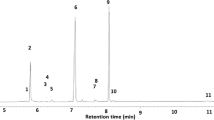Abstract
A bioassay system was developed that permits the testing of various substrates for biological activity in a flight tunnel, while simultaneously collecting a portion of the volatiles from the attractive source for subsequent chemical identification and quantification. Bioassays of the response of virgin female Caribbean fruit flies,Anastrepha suspensa (Loew) (Diptera: Tephritidae), to volatiles released by calling males were conducted in a greenhouse under natural light cycles and fluctuating environmental conditions, similar to those in the field. Using this system, the periodicity of response of the female flies between 1300 and 1845 hr (EST) was tested. Fifty to 75% response occurred between 1700 and 1845 hr. Male pheromone release was greatest between 1500 and 1800 hr. Videotaped records of insects, taken between 1700 and 1800 hr as flies approached and entered the traps, were analyzed to interpret the communicative role of the volatiles released. Significantly more flies landed on and entered the pheromone-emitting trap than the control trap. There was no difference in the amount of time spent on the trap face, an indication that volatiles were attractants. The system described should be of general utility in determination of the attraction of pest fruit flies to suspected attractants.
Similar content being viewed by others
References
Baker, T.C., andLinn, C.E., Jr. 1984. Wind tunnels in pheromone research, pp. 75–110,in H.E. Hummel and T.A. Miller (eds.). Techniques in Pheromone Research. Springer-Verlag, NewYork.
Chuman, T., Sivinski, J., Heath, R.R., Calkins, C.O., Tumlinson, J.H., Battiste, M.A., Wydra, R.L., Strekowski, L., andNation, J.L. 1988. Suspensolide, a new macrolide component of male Caribbean fruit fly (Anastrepha suspensa [Loew]) volatiles.Tetrahedron Lett. 29(50):6561–6564.
Epsky, N.D., andHeath, R.R. 1993. Pheromone production by males ofAnastrepha suspensa (Diptera: Tephritidae) under natural light cycles in greenhouse studies.Environ. Entomol. 22:464–469.
Greany, P.D., Agee, H.R., Burditt, A.K., Jr., andChambers, D.L. 1977. Field studies on color preferences of the Caribbean fruit fly,Anastrepha suspensa (Diptera: Tephritidae).Entomol. Exp. Appl. 21:63–70.
Grob, J.J. 1982. Band broadening in space and the retention gap in capillary gas chromatography.J. chromatography. 237:15–23.
Heath, R.R., andManukian, A. 1992. Development and evaluation of systems to collect volatile semiochemicals from insects and plants using charcoal-infused medium for air purification.J. Chem. Ecol. 18:1209–1226.
Heath, R.R., Landolt, P.J., Dueben, B.D., Murphy, R.E., andSchneider, R.E. 1992. Identification of a male-produced pheromone of cabbage looper moths attractive to conspecific females.J. Chem. Ecol. 14:441–453.
Kovats, E. 1965. Retention index system.Adv. Chromatogr. 1:229–234.
Landolt, P.J., Reed, H.C., andHeath, R.R. 1992. Attraction of female papaya fruit fly (Diptera: Tephritidae) to male pheromone and host fruit.Environ. Entomol. 21:1154–1159.
Murphy, R.E. 1989. The fractionation gap: a optimized coupling of fused silica columns in open tubular gas chromatography. Master's thesis. University of Florida, Gainesville, FL.
Nation, J.L. 1975. The sex pheromone blend of Caribbean fruit fly males: Isolation, biological activity and partial chemical characterization.Environ. Entomol. 4:27–30.
Nation, J.L. 1990. Biology of pheromone release by male Caribbean fruit flies,Anastrepha suspensa (Diptera: Tephritidae).J. Chem. Ecol. 16:553–572.
Nation, J.L. 1991. Sex pheromone components ofAnastrepha suspensa and their role in mating behavior, pp. 224–236,In K. Kawasaki, O. Iwahashi, and K.Y. Kaneshiro (eds.). Proceedings of the International Symposium on the Biology and Control of Fruit Flies. Ginowan, Okinawa, Japan.
Rocca, J.R., Nation, J.L., Strekowski, L., andBattiste, M.A. 1992. Comparison of volatiles emitted by male Caribbean and Mexican fruit flies.J. Chem. Ecol. 18:223–244.
SAS Institute 1985. SAS/STAT guide for personal computers, version 6 edition. SAS Institute, Cary, North Carolina.
Author information
Authors and Affiliations
Rights and permissions
About this article
Cite this article
Heath, R.R., Manukian, A., Epsky, N.D. et al. A bioassay system for collecting volatiles while simultaneously attracting tephritid fruit flies. J Chem Ecol 19, 2395–2410 (1993). https://doi.org/10.1007/BF00979673
Received:
Accepted:
Issue Date:
DOI: https://doi.org/10.1007/BF00979673




